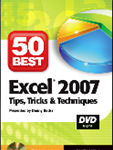You can use the Indirect Function to create an Excel Dashboard. A Dashboard gives you an overview of your data – in this case, an interactive view of the information hidden in our data set. I will create Drop-Down lists using Data Validation in the Dashboard. The Indirect Function takes a little bit of time to understand. Here are some key points:
- The Indirect Function works best with Named Cell References
- The syntax is =INDIRECT(reference text). In our example the “reference text” will be the label for a Named Range of cells.
- You can “nest” the Indirect Function inside another function – e.g. =SUM(INDIRECT())
Later in the lesson, I show you how you can quickly look up any cell at the “intersection” of a Named Row and a Named Column – e.g. April East. You use the SPACE BAR as the “Intersection Operator” to point to the cell where “April” meets “East.”
Some of the Keyboard Shortcuts that I use in this lesson are:
- Ctrl + A to select all of the cells in a Data Set
- F3 to bring up a list of all the Named Ranges that have been created in the current workbook
- Ctrl + Shift + F3 to create Named Ranges for the cells in the selection – using as Names, the Labels in the Top Row / Left Column
Here is a link to the 1st lesson in this series on the INDIRECT Function in Excel.
Follow this link to watch this lesson in High Definition, Full Screen Mode on YouTube.
You can learn how to “Master Excel in Minutes – Not Months!”
 How to Use the Indirect Function to Create Excel Dashboards [ 7:20 ] Play Now | Play in Popup | Download (1168)
How to Use the Indirect Function to Create Excel Dashboards [ 7:20 ] Play Now | Play in Popup | Download (1168)

